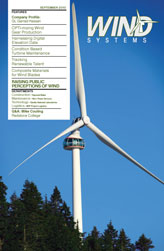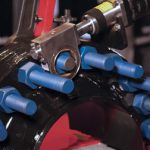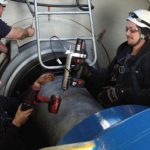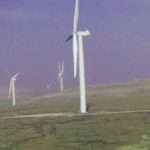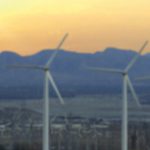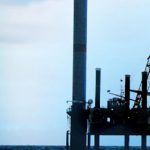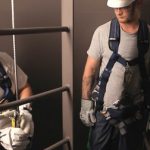Atop Grouse Mountain—one of the North Shore Mountains in Vancouver, British Columbia, Canada—sits the Eye of the Wind, the world’s first wind turbine viewing tower with a public elevator. Built earlier this year, the Eye of the Wind viewing pod transforms the wind turbine from a passive element of the scenic landscape into an interactive, perspective-altering tourist attraction.
For the wind industry, it allows the public to personally experience the true power and potential of wind energy from the perspective of the turbines that harvest it (Figure 1). For the construction industry, the viewing pod is an example of how existing techniques can be used for new and unique projects; even those that pose tremendous challenges.
In this case, KONE lived up to the challenge to build a 20-story elevator for the public, all in a structure that is continuously moving, required protection from earthquakes, and offered one-third the amount of space for a normal elevator. While not every turbine requires a public elevator, the experience proves how teamwork and innovation can help meet even the most challenging obstacles in transporting people safely and efficiently.
Grouse Mountain
Grouse Mountain is known for its sustainability platforms, and harvesting energy from the wind was a natural for the developers. But in this case they wanted more than just an industrial use for the tower. They wanted to promote the new technology, and to increase demand from consumers for clean energy. “The Eye of the Wind is an iconic symbol of sustainable wind energy that encourages visitors from around the globe to demand alternative energy solutions in their own hometowns,” says Chris Dagenais, director of communications for Grouse Mountain.
The Eye of the Wind tower stands 223 feet (65 meters) high and provides a breathtaking scenic view 4,176 feet (1,273 meters) above sea level of Grouse Mountain, recently highlighted during the Vancouver Winter Games.
Each year over 1.2 million people visit Grouse Mountain from around the globe, including Canada, the United States, Japan, Korea, Germany, and the United Kingdom. For these visitors the revolutionary viewing pod represents one of the most recent innovations in eco-tourism, allowing tourists a breathtaking view and the chance to learn about the next generation of energy technology.
Construction
Getting from idea to completion posed many challenges including the turbine’s mountaintop location, the size and weight of its components, and the points of origin around the world. The turbine’s 122 foot (37.3 meters) blades were airlifted to the peak of the mountain after arriving in Vancouver via barge. Each weighing more than 50 tons, the tower sections arrived at the construction site after a tediously slow trek up Grouse Mountain’s eight miles of winding back roads. Even the large, pre-assembled viewPOD™ traveled across Canada on train before arriving in Vancouver.
On top of that engineers had to decide how to house not just the observation pod, but also the elevator that provides access for the public to the Eye of the Wind. KONE was selected for this project, working closely with a number of different contractors to finish the job on time and successfully. Figure 2
Elevator Planning
The first challenge for the elevator planning was the timing for the entire project. Construction of the entire project required assembling the tower as it arrived in pieces. For engineers this meant that installation of the access elevator could proceed only after the tower was fully erected. For the elevator planning KONE engineers had to take into account the limited space inside the tower, the seismic requirements of Grouse Mountain, and the tower’s continuously swinging structure.
Consider these space issues: While the base of the tower measured a standard 13 feet (3.96 meters) in diameter, the tower tapers to just over 6 ½ feet (2 meters) at the top. That space on the top allows for only one-third of the space of an average elevator shaft. To meet those tight requirements, the tower was fitted with KONE’s MonoSpace© solution, which doesn’t require a machine room and is powered by KONE’s EcoDisc hoisting technology, allowing engineers to maximize use of the restricted space while ensuring a safe, energy efficient, and comfortable trip to the top.
KONE has pioneered the “machine-room-less” (MRL) technology, allowing more and more commercial, residential, and industrial buildings the advantage of greater design flexibility. With this technique there is no need for the bulky elevator room above the top floor. Such a design would have been impossible at the Eye of the Wind, and it is increasingly falling out of favor in more-traditional structures. In addition, KONE’s solution is more energy efficient than traditional technology, another benefit for all structures. This approach is up to 70 percent more efficient than a hydraulic device, and 50 percent more efficient than a traditional traction unit.
After the size of the elevator was determined, engineers turned their attention to Grouse Mountain’s location in an active fault region. KONE’s Marine Department was called in to help design and implement the structure, as that department has experience with moving structures. In this case, the land on Grouse Mountain is part of an active fault line, so it is literally moving. At the same time, the pressure from the wind and design of the structure itself—which pivots to capture the best winds—means that the structure is constantly moving. The unique solution combines KONE’s elevator technology with a seismic installation and an emergency brake release system. All of these features working together provide a safe and efficient manner to visit the Eye of the Wind.
“This project was unique in that it drew on existing technologies but applied them in an innovative way,” according to John Hemgard, coordinator of the project at KONE Marine & Major Projects. “So many people worked together to make this happen, from the turbine builder to Grouse Mountain to the local KONE installation team. This was a clear example of how existing KONE technologies were used by the teams, which collaborated and drove the completion of the project.” Figure 3
The Visitor Experience
The Eye of the Wind gives visitors the chance to experience wind power from a revolutionary perspective. The vast majority of the population is familiar with wind turbines simply through magazine articles, documentaries, or by witnessing them churning away in the distance, but very few people have the opportunity to see them in person. Until now, almost no one has been able to experience the harvesting potential from The Eye of the Wind. Overlooking Greater Vancouver’s bustling harbor, the pristine Coastal Mountain Range, and the vast, green wilderness of the Canadian countryside, The Eye of the Wind provides visitors with unprecedented 360-degree views from the sky. Visitors begin the ascent to the top with a 35 second elevator ride.
After exiting the elevator, visitors step into the viewPod™, a glass-encased room suspended directly below the hub of the turbine’s blades. The room also features a glass segment on the floor, allowing visitors to look down at the ground and fully appreciate the tower’s height and magnitude. The experience is described as similar to flying in the clear plexiglas nose bubble of a helicopter, only the viewPod is approximately 30 times larger. Once they have entered it, visitors can literally feel the movement of the giant turbine blades. On a clear day they can see southeast to snow-capped Mount Baker and Mount Rainier, and to the north their sister mountain, Mount Garibaldi. All three are part of the still-volcanic Cascade Range of western North America. Directly to the west and southwest lie Vancouver Island, the Gulf Islands, the San Juan Islands, and the Olympic Mountains. Depending on the time and day, views from The Eye of the Wind may include sunsets, sunrises, and the silver-gray storms that blow in off the Pacific Ocean.
“Days with clear, sunny weather tend to be the most popular,” Dagenais says. “However, the public is beginning to realize that days with inclement weather provide the opportunity to see the tower in action, when it is generating electricity.”
The Benefits of Tourism
The viewPod presents the public with an opportunity to experience the true power of wind energy, making The Eye of the Wind an important educational vehicle for the wind industry. For many years wind turbines have been perceived as the massive, sometimes imposing structures read about in magazines or driven by on the highway, not structures known and enjoyed personally. By providing a face-to-face, intimate glimpse into the wind industry, The Eye of the Wind introduces the concept of wind power to tourists and allows them to get comfortable with the industry as it expands.
Individuals take away the grace of the turbine blades circling in the air and the majestic views from the top of the tower. The whole experience dispels the myths and rumors about noise pollution from the blades and amends the public perception of the towers’ unsightly nature.
To make that access a reality, the public elevator was necessary to safely and quickly move visitors to the top of the structure. The Eye of the Wind is at the cutting edge of a trend to turn wind turbines into tourist attractions and create additional sources of revenue for wind farm owners. Turbines can now be seen as part of the environments in which they stand, becoming tourist attractions rather than simply accessories to scenic landscapes. Figure 4
Future Opportunities
Throughout the world turbine owners are taking steps to attract curious visitors and educate tourists on the value of wind energy. For example, wind farms are building visitor centers to attract and educate tourists on the value of wind energy. Companies are developing boat tours to take tourists out to sea and visit offshore wind farms in Michigan. Even tourist destinations at remote offshore farms are being conceptualized: one Norwegian design firm’s concept, “Turbine City,” places a hotel, spa, and cultural museum at the base of an offshore wind turbine.
Already people are paying to visit wind turbines and be photographed with them. At Whitelee, Europe’s largest wind farm, over 25,000 people toured the visitor center in its first nine weeks of operation. The center is located in a fairly remote area of Scotland that has not previously attracted much tourist attention, suggesting that the lure of wind power to tourists is strong.
Conclusion
From the project’s start to its meticulous finish, The Eye of the Wind has truly become more powerful as a whole than the sum of its parts. The project’s turbine, its revolutionary viewing tower, and the access elevator that makes the experience possible symbolize the kind of creativity, innovation, and collaboration taking place in the sustainable energy industry. It is the most recent marketable wind energy advancement and a leading example of eco-tourism to advance the wind energy cause, and KONE is proud of its participation in this project.



















